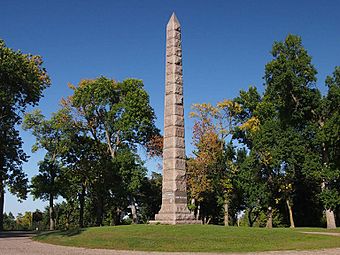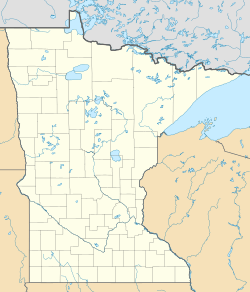Camp Release State Monument facts for kids
Quick facts for kids |
|
|
Camp Release State Monument
|
|

Camp Release State Monument
|
|
| Nearest city | Montevideo, Minnesota |
|---|---|
| Built | 1894 |
| NRHP reference No. | 73000981 |
| Added to NRHP | March 14, 1973 |
The Camp Release State Monument is a special place in Montevideo, Minnesota. It's located in Lac qui Parle County, right off Highway 212. This monument helps us remember an important part of Minnesota's early history. The area around the Minnesota River Valley and Montevideo played a big role in the Dakota War of 1862.
On September 26, 1862, something very important happened here. After a conflict, 269 people who had been taken captive were released. This happened to Colonel Henry Hastings Sibley at a spot known as Camp Release. This spot is on a bluff overlooking the valley where Montevideo is today.
The Camp Release State Monument was one of the first monuments built by the Minnesota legislature. It was the sixth of 23 state monuments created between 1873 and 1929. It was also the first property added to the state park system. In 1973, it was officially listed on the National Register of Historic Places.
Contents
What Happened at Camp Release?
The Camp Release Monument was officially dedicated on July 4, 1894. It honors the day when 269 captives were released. Most of these captives were women and children. This event took place on September 26, 1862.
The Monument's Message
The northern side of the monument has an inscription. It says that the release was "The result mainly of the signal victory over the Sioux at Wood Lake." This victory was won by Minnesota troops led by General Henry H. Sibley. The southern side of the monument simply says "Camp Release."
The other two sides of this 51-foot granite monument also have important information:
- The eastern side lists the dates of battles along the Minnesota River during the conflict.
- The western side explains that the State of Minnesota built the monument. It was approved by a law on April 11, 1893. It also names the committee members who supervised its building.
The Camp Release Marker
In 1989, the Minnesota Historical Society put up a new marker at Camp Release. This marker gives more details about the event. It states that on September 26, 1862, 91 white people and about 150 mixed-blood captives were released. Some of them had been held by the Dakota for over a month.
The marker also explains that more captives were freed in the next few days. This brought the total to 107 white people and 162 mixed-blood people, making 269 in all.
The Role of the Dakota Peace Group
The marker also recognizes the important role played by the Dakota "peace faction." These were Dakota people who did not support the conflict. They took big risks to help keep the captives safe.
By late September, Dakota peace groups were camped near the war group. Leaders like Wabasha, Taopi, Red Iron, Mazomani, and Standing Buffalo led these groups. While other Dakota were fighting at the Battle of Wood Lake, the peace supporters took control of the captives. They were ready to fight the returning war party if they won against Sibley's army.
However, the war leaders did not win at Wood Lake. Many of them and their followers left Minnesota. The Dakota peace group then sent a message to Sibley. They arranged for the prisoners to be released three days later.
The Camp Release Marker also mentions that some of the Dakota who surrendered were part of the peace group. Many of these peace faction members were later exiled from Minnesota the following year. The Minnesota Historical Society has since updated the total number of captives released at Camp Release to 285.



